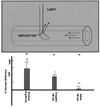Applications of optical coherence tomography in cardiovascular medicine, part 1
- PMID: 19224151
- PMCID: PMC4352580
- DOI: 10.1007/s12350-009-9060-6
Applications of optical coherence tomography in cardiovascular medicine, part 1
Figures























Similar articles
-
Current capabilities and challenges for optical coherence tomography as a high-impact cardiovascular imaging modality.Circulation. 2011 Jun 28;123(25):2913-5. doi: 10.1161/CIRCULATIONAHA.111.034272. Circulation. 2011. PMID: 21709070 Free PMC article. No abstract available.
-
[Optical coherence tomography].Ophthalmologe. 2004 Aug;101(8):775-6. doi: 10.1007/s00347-004-1051-z. Ophthalmologe. 2004. PMID: 15459786 German. No abstract available.
-
Special section guest editorial: selected topics in biophotonics: optical coherence tomography and medical imaging using diffuse optics.J Biomed Opt. 2012 Jul;17(7):071301. doi: 10.1117/1.JBO.17.7.071301. J Biomed Opt. 2012. PMID: 22894462 No abstract available.
-
Optical coherence tomography in biomedical research.Anal Bioanal Chem. 2011 Jul;400(9):2721-43. doi: 10.1007/s00216-011-5052-x. Epub 2011 May 12. Anal Bioanal Chem. 2011. PMID: 21562739 Review.
-
Optical coherence tomography: history, current status, and laboratory work.Invest Ophthalmol Vis Sci. 2011 Apr 14;52(5):2425-36. doi: 10.1167/iovs.10-6312. Print 2011 Apr. Invest Ophthalmol Vis Sci. 2011. PMID: 21493951 Free PMC article. Review.
Cited by
-
Intravascular optical coherence tomography measurement of size and apposition of metallic stents.Biomed Opt Express. 2013 Aug 30;4(10):1876-82. doi: 10.1364/BOE.4.001876. eCollection 2013. Biomed Opt Express. 2013. PMID: 24156050 Free PMC article.
-
Evaluation of IVOCT imaging of coronary artery metallic stents with neointimal coverage.Int J Cardiovasc Imaging. 2015 Mar;31(3):463-70. doi: 10.1007/s10554-014-0569-7. Epub 2014 Nov 14. Int J Cardiovasc Imaging. 2015. PMID: 25395364 Free PMC article.
References
-
- Regar E, van Leeuwen TG, Serruys PW, editors. Optical coherence tomography in cardiovascular research. 1st ed. London: Informa Healthcare; 2007.
-
- Bouma BE, Tearney GJ, editors. Handbook of optical coherence tomography. 1st ed. New York: Marcel Dekker, Inc; 2002.
Publication types
MeSH terms
Grants and funding
LinkOut - more resources
Full Text Sources

